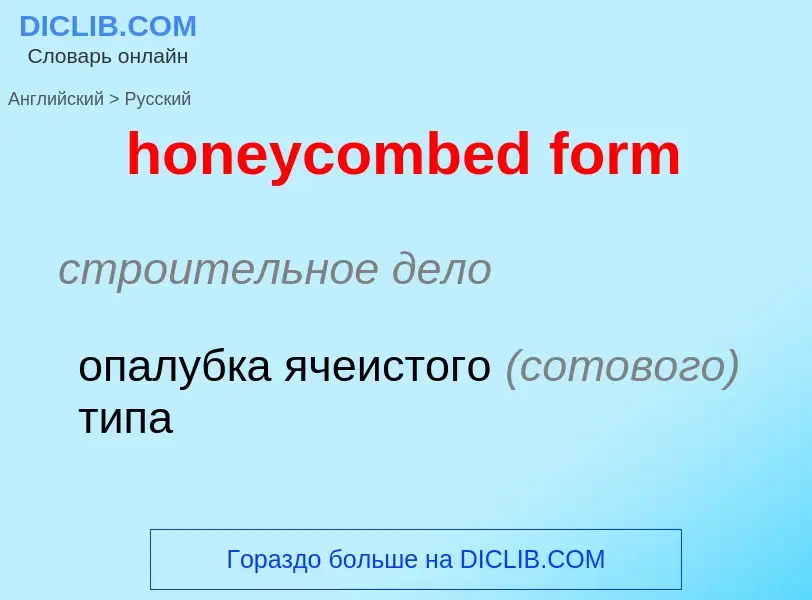Traduzione e analisi delle parole tramite l'intelligenza artificiale ChatGPT
In questa pagina puoi ottenere un'analisi dettagliata di una parola o frase, prodotta utilizzando la migliore tecnologia di intelligenza artificiale fino ad oggi:
- come viene usata la parola
- frequenza di utilizzo
- è usato più spesso nel discorso orale o scritto
- opzioni di traduzione delle parole
- esempi di utilizzo (varie frasi con traduzione)
- etimologia
honeycombed form - traduzione in russo
строительное дело
опалубка ячеистого (сотового) типа
каноническая форма; канонический вид
Definizione
Wikipedia
A cannon is a large-caliber gun classified as a type of artillery, which usually launches a projectile using explosive chemical propellant. Gunpowder ("black powder") was the primary propellant before the invention of smokeless powder during the late 19th century. Cannons vary in gauge, effective range, mobility, rate of fire, angle of fire and firepower; different forms of cannon combine and balance these attributes in varying degrees, depending on their intended use on the battlefield. A cannon is a type of heavy artillery weapon.
The word cannon is derived from several languages, in which the original definition can usually be translated as tube, cane, or reed. In the modern era, the term cannon has fallen into decline, replaced by guns or artillery, if not a more specific term such as howitzer or mortar, except for high-caliber automatic weapons firing bigger rounds than machine guns, called autocannons.
The earliest known depiction of cannons appeared in Song dynasty China as early as the 12th century; however, solid archaeological and documentary evidence of cannons do not appear until the 13th century. In 1288 Yuan dynasty troops are recorded to have used hand cannon in combat, and the earliest extant cannon bearing a date of production comes from the same period. By the early 14th century, possible mentions of cannon had appeared in the Middle East and the depiction of one in Europe by 1326. Recorded usage of cannon began appearing almost immediately after. They subsequently spread to India, their usage on the subcontinent being first attested to in 1366. By the end of the 14th century, cannons were widespread throughout Eurasia. Cannons were used primarily as anti-infantry weapons until around 1374, when large cannons were recorded to have breached walls for the first time in Europe. Cannons featured prominently as siege weapons, and ever larger pieces appeared. In 1464 a 16,000 kg (35,000 lb) cannon known as the Great Turkish Bombard was created in the Ottoman Empire. Cannons as field artillery became more important after 1453, with the introduction of limber, which greatly improved cannon maneuverability and mobility. European cannons reached their longer, lighter, more accurate, and more efficient "classic form" around 1480. This classic European cannon design stayed relatively consistent in form with minor changes until the 1750s.


![Battle of the Somme]] Battle of the Somme]]](https://commons.wikimedia.org/wiki/Special:FilePath/British 39th Siege Battery RGA Somme 1916.jpg?width=200)



![Malik E Maidan, a 16th-century cannon, was effectively used by the [[Deccan sultanates]], and was the largest cannon operated during the [[Battle of Talikota]]. Malik E Maidan, a 16th-century cannon, was effectively used by the [[Deccan sultanates]], and was the largest cannon operated during the [[Battle of Talikota]].](https://commons.wikimedia.org/wiki/Special:FilePath/Malik E Maidan.jpg?width=200)
![A bronze "thousand ball thunder cannon" from the ''[[Huolongjing]]''. A bronze "thousand ball thunder cannon" from the ''[[Huolongjing]]''.](https://commons.wikimedia.org/wiki/Special:FilePath/Ming Dynasty field artillery cannon.jpg?width=200)
![Armstrong gun deployed by Japan during the [[Boshin war]] (1868–69). Armstrong gun deployed by Japan during the [[Boshin war]] (1868–69).](https://commons.wikimedia.org/wiki/Special:FilePath/Sagahan Armstrong gun used at the Battle of Ueno against the Shogitai 1868.jpg?width=200)
![The first Western image of a battle with cannon: the [[Siege of Orléans]] in 1429 The first Western image of a battle with cannon: the [[Siege of Orléans]] in 1429](https://commons.wikimedia.org/wiki/Special:FilePath/Siege orleans.jpg?width=200)


![Bronze cannon with inscription dated the 3rd year of the Zhiyuan era (1332) of the [[Yuan Dynasty]] (1271–1368); it was discovered at the [[Yunju Temple]] of [[Fangshan District]], [[Beijing]] in 1935. Bronze cannon with inscription dated the 3rd year of the Zhiyuan era (1332) of the [[Yuan Dynasty]] (1271–1368); it was discovered at the [[Yunju Temple]] of [[Fangshan District]], [[Beijing]] in 1935.](https://commons.wikimedia.org/wiki/Special:FilePath/Yuan Bronze Cannon.jpg?width=200)
![Cannon from the 15th century at [[Šibenik]] city walls Cannon from the 15th century at [[Šibenik]] city walls](https://commons.wikimedia.org/wiki/Special:FilePath/Šibenik - topovi.jpg?width=200)

![quadrants]] for improved precision. quadrants]] for improved precision.](https://commons.wikimedia.org/wiki/Special:FilePath/Fotothek df tg 0000132 Ballistik ^ Quadrant ^ Kanone.jpg ?width=200)
![The use of [[gabion]]s with cannon was an important part in the attack and defence of fortifications. The use of [[gabion]]s with cannon was an important part in the attack and defence of fortifications.](https://commons.wikimedia.org/wiki/Special:FilePath/Sixteenth Century Cannon2.jpg ?width=200)
![[[Fort Bourtange]], a [[bastion fort]], was built with angles and sloped walls specifically to defend against cannon. [[Fort Bourtange]], a [[bastion fort]], was built with angles and sloped walls specifically to defend against cannon.](https://commons.wikimedia.org/wiki/Special:FilePath/Fortbourtange.jpg ?width=200)
![[[Westland C.O.W. Gun Fighter]] with 37mm C.O.W. gun mounted to fire upwards [[Westland C.O.W. Gun Fighter]] with 37mm C.O.W. gun mounted to fire upwards](https://commons.wikimedia.org/wiki/Special:FilePath/Westland C.O.W. Gun Fighter.jpg ?width=200)
![[[Supermarine Spitfire]] with 20 mm cannon protruding from the leading edge of the wing [[Supermarine Spitfire]] with 20 mm cannon protruding from the leading edge of the wing](https://commons.wikimedia.org/wiki/Special:FilePath/Supermarine Spitfire Mk XVI.jpg?width=200)
![[[GSh-23]] autocannon mounted on the underside of a [[Mikoyan-Gurevich MiG-23]] [[GSh-23]] autocannon mounted on the underside of a [[Mikoyan-Gurevich MiG-23]]](https://commons.wikimedia.org/wiki/Special:FilePath/GSh-23 on MiG-23.jpg ?width=200)
![The [[GAU-8/A Avenger]] rotary cannon, mounted in a [[Fairchild A-10 Thunderbolt II]] The [[GAU-8/A Avenger]] rotary cannon, mounted in a [[Fairchild A-10 Thunderbolt II]]](https://commons.wikimedia.org/wiki/Special:FilePath/GAU-8 in A-10.jpg ?width=200)
